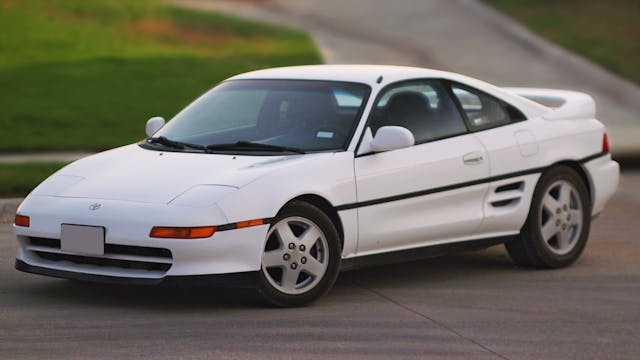Media | Articles
Toyota’s 1990–99 MR2 (SW20) packs a supercar punch on a Camry budget
We can all agree mid-engine cars are awesome. However, if you’re in the market for a mid-engine car that won’t break your budget, there aren’t many options. Among most mid-engine models, you will need to sacrifice reliability or performance to get a good deal. That’s not the case with the second-generation Toyota MR2 (SW20). Where else can you get supercar-tier performance, legendary build quality, and everyday practicality, all packaged in a timeless design?
Let’s dig deeper to figure out what makes this car so great.
The SW20 Toyota MR2 was sold new starting in 1990, right after the original MR2 ended production. Although Toyota produced the car until 1999, North America only received the 1991–95 model years; but the MR2 we got was truly remarkable.
The original MR2 set lofty expectations, so when the time came to build a new model, Toyota had to put its hand to the proverbial plow. Toyota designers rose to the challenge, determined to address the MR2’s flaws and build on its strengths. The new MR2 was made more spacious and luxurious than its predecessor, and those improvements made the MR2 much more livable with an impressive 6.5 cubic feet of cargo volume—a 30 percent increase over the original MR2.
The extra space and luxury came at a price; the SW20 is the heaviest of the three MR2 generations. The SW20 MR2 Turbo weighed nearly 2900 pounds—a whole 400 pounds more than the heaviest Mk I trim and 700 pounds above the MR2 Spider that followed. Thankfully, Toyota offset the extra weight with more power.
Marketplace
Buy and sell classics with confidence
Engineers once again utilized forced induction to squeeze the most out of the little four-cylinder, deciding to swap the original MR2’s supercharger for a turbo. The SW20 MR2 Turbo made 200 hp and 200 pound-feet of torque from the turbocharged and intercooled 2.0-liter 3S-GTE inline-four. (Toyota diehards will recognize that engine from the Celica GT-Four, a homologation special that dominated Group A Rally in the early ’90s.) In the MR2 Turbo, the 3S-GTE was good for a 6.1-second sprint to 60 mph and 14.7 second quarter-mile—not bad for 1991.

The wedged styling of the SW20 MR2 has aged well. Even 30 years later, the car doesn’t look out of place. The popup headlights and T-top roof are reminiscent of the times but still modern. The side vents, a characteristic of most mid-engine cars, are functional—air is fed to the intercooler through the passenger-side vent, while the engine breathes from an intake in the driver-side vent.
Due to the strakes in the side vents and other Italian-derived styling cues, the SW20 MR2 was often called “the poor man’s Ferrari,” but Toyota got the last laugh. The MR2 Turbo for the Japanese market was eventually tuned to 242 hp and could lay down a 13.1-second quarter mile, outrunning the Ferrari 348, NSX, and Supra Twin-Turbo of the time. Since the North American MR2 Turbo only topped out at 200 hp, we can again complain that America didn’t get the best version of a Japanese sports car—but what else is new? We shouldn’t whine too much, because Europe was never offered the Turbo model and only ever saw a naturally aspirated MR2.

By now, you’ve probably opened a Craigslist tab to search for a good MR2. Here are a few pointers in your quest. First, don’t be shocked by the price. You can expect to pay anywhere from $8000 for a #3-condition (Good) non-turbo example all the way up to $35,000 for concours-quality turbo MR2, but it’s worth it.
Like all 1990s Toyotas, the SW20 MR2 is extremely reliable. However, if you need to do any engine work, be prepared for a time-consuming process. In order to fit the engine neatly between the axles, Toyota was forced to package some parts out of reach. A notorious example are the coolant hoses on Turbo models, which are buried deep within the engine compartment and surrounded by many other parts. They have been dubbed the “Hoses from Hell” by the MR2 community, because they essentially require an engine-out service to replace.
Even though the engines were bulletproof, the SW20 MR2 suffered a high attrition rate. The SW20 MR2 was prone to snap-oversteer, which occurs when a driver enters a corner too quickly and lifts off the throttle mid-corner, shifting the weight forward. As the rear tires loose traction, the rear weight bias of the MR2 causes the back end to swing out. If the driver over-corrects, the heavy rear of the MR2 will snap back and send the car into a spin. (Watch the black MR2 in front of the driver in this video.) Snap oversteer isn’t really a problem if you’re a Formula 1 driver like Dan Gurney (who helped Toyota engineers fine-tune the handling of the first two MR2 generations), but the MR2 was many owners’ first mid-engine car. Combined with a novice driver, an MR2’s worst enemy was a tree.
The overbuilt transaxle, large catalog of aftermarket performance parts, and “used-car” purchase price made the SW20 a prime candidate for tuning. This also attracted young, inexperienced drivers who would spin them into ditches. It can be very difficult to find a clean, unmodified example, and if you find one, make sure you know the car’s history.
In a response to the MR2’s snap oversteer, Toyota revised the suspension and added wider tires for the 1993 model year. Proving you can never make everyone happy, some journalists claimed the changes neutered the wild character of the MR2 and that snap oversteer could be handled with better driver response; after all, it’s a common issue in most mid-/rear-engine cars. Toyota stuck by its revisions, claiming that the changes were made “for drivers whose reflexes were not those of Formula 1 drivers.”

The Honda S2000 crowd argues over the virtues of AP1 versus AP2 cars; fans of the SW20 debate whether the 1991–92 or the 1993–95 MR2s are superior. MR2s produced before the 1993 revisions are considered a purer interpretation of the designers’ original intent; post-revision MR2s are less common and offer larger brakes and a viscous limited-slip-differential. Only about 19 percent of the SW20 MR2s imported to the U.S. were post-revision cars. Due to its rarity, a post-revision MR2 Turbo in #2 (Excellent) condition carries a 26.6 percent premium over a pre-revision Turbo ($23,800 vs. $18,800).
On average, naturally-aspirated models are worth a little more than half a Turbo ($12,300 vs. $22,500 for #2-condition 1993 MR2 models). Additional power and lower production numbers are the main factors in the Turbo’s premium, but this model also came with some additional features. Along with bigger brakes, raised engine vents, and fog lamps, Turbo models got an extra interior storage compartment between the two seats. Other than cost savings, there isn’t a clear reason why this compartment wasn’t offered on the naturally aspirated models.
Like the Turbo model, naturally aspirated post-revision cars are worth a little more—4 percent for a #2-condition car. For the 1994–95 model years, naturally aspirated models were tuned for an additional 5 hp, resulting in an additional 6 percent premium. Expect to pay around $13,000 for a 1994–95 naturally aspirated MR2.

The SW20 MR2 is gaining momentum in the market. Since January 2020, #2-condition Turbo models saw a 25 percent value increase in the Hagerty Price Guide. In that same time, price lookups on Hagerty Valuation Tools increased 55 percent. Using insurance quotes as a sign of interest, the SW20 MR2 has seen consistent growth over the last year, with a 22 percent increase. Millennials show the most interest, making up 55 percent of quotes—Gen-X follows at 31 percent.
Toyota didn’t officially make any limited-production versions of the SW20, but there were a few factory-modified versions that will soon be legal to import. Starting in 1998, Toyota Racing Development (TRD) offered an official body kit and tuning that transformed a stock MR2 into a widebody TRD2000GT clone—paying homage to the GT-C Japanese series race car of the same name. No two TRD2000GTs are the same, as customers could select which additional engine, suspension, and interior upgrades they wanted. Less than 50 of these cars were built, each receiving a new TRD VIN plate. It’s possible to buy a replica TRD widebody kit, but these cars won’t have a real TRD VIN.
It’s rumored that with full TRD performance upgrades, the TRD2000GT MR2 produced over 500 hp and weighed under 2500 pounds. Let me know if you’re lucky enough to find a real one.
Like this article? Check out Hagerty Insider, our e-magazine devoted to tracking trends in the collector car market.












